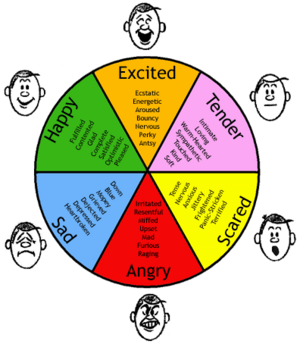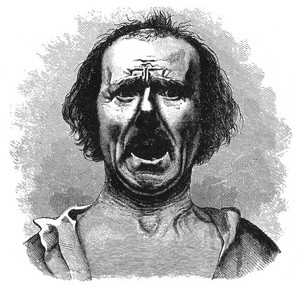Emotion facts for kids
Emotions are the feelings people have. They are very old, going back to when mammals first appeared. Even animals feel emotions!
Emotions come from a mix of hormones (body chemicals) and parts of our unconscious mind (thoughts we aren't always aware of). It can be hard to control our emotions just by thinking about it. Emotions make us and other animals change how we act depending on what's happening around us. Sometimes, our emotions make it hard to think clearly or logically.
Scientists have many ways to define emotion. Over 90 different definitions have been offered! A good definition of emotion usually includes three things:
- What we feel inside (our conscious experience).
- What others can see (like our facial expressions).
- How our body reacts (like a racing heart, called physiological arousal).
Here is one way to define emotion: "Emotion is a complex psychological event that happens as animals or people live their lives. Emotions involve body reactions, understanding the situation, showing expressions, and conscious feelings. Emotion is linked to how we feel, our mood, temperament, personality, disposition, and what motivates us."
In our bodies, emotions involve systems that have been around for millions of years. These include our hormone system, the autonomic nervous system (which controls things like breathing and heart rate), and the lower parts of our brain (like the hindbrain and midbrain).
Contents
What Are Emotions?
The word "emotion" first appeared in English in 1579. It came from the French word émouvoir, which means "to stir up." The term "emotion" was used to describe feelings like passions, sentiments, and affections.
Some people think emotions are strong feelings aimed at someone or something. But emotions can also be mild, like feeling annoyed or content. They can also be feelings not aimed at anything specific, like Anxiety or depression. How we use the word "emotion" in everyday talk can be different from how scientists use it. Also, other languages have words similar to "emotion," but they might not mean exactly the same thing.
Scientists describe emotions as quick, clear reactions to things that are important to us. Emotions don't last long. They involve many body responses, like how we speak, what our body does, how we act, and what happens in our nerves. A psychotherapist named Michael C. Graham says that all emotions exist on a scale of how strong they are. For example, fear can range from a small concern to pure terror. Shame can be mild embarrassment or very deep shame. Emotions are also seen as something we are born with, a result of evolution. This is because they helped our ancestors solve problems and survive. Moods are feelings that are usually less strong than emotions and last longer. They often don't have a clear reason why they started.
Emotion is different from some other similar words in science:
- Feelings are how we personally experience emotions. They are private to the person feeling them.
- Moods are general feelings that last much longer than emotions. They are also usually less strong.
- Affect is a bigger word that includes emotions, feelings, and moods. Sometimes, people use "affect" and "emotion" to mean the same thing.
Emotions can also have positive or negative effects on each other. Some emotions are direct opposites. These ideas are explored in how emotions are classified and grouped. Graham also says that emotions can be helpful (functional) or unhelpful (dysfunctional), and all helpful emotions have benefits.
Parts of an Emotion
In Klaus Scherer's model of emotion, there are five key parts that make up an emotion. These parts work together very quickly when an emotion happens, driven by how we understand a situation. Even though some scientists disagree about whether thinking (cognition) is part of emotion, this model helps explain how everything works together during an emotional moment.
- Cognitive appraisal: This is how we figure out what an event or object means to us.
- Bodily symptoms: These are the physical changes in our body, like a fast heartbeat or sweating.
- Action tendencies: This is the urge to do something, like run away when scared.
- Expression: Our face and voice almost always show our emotional state. This helps us communicate how we feel and what we might do.
- Feelings: This is the actual feeling we have once the emotion has started.
How Emotions Are Grouped
We can talk about emotional moments (like feeling angry right now) and emotional habits (like being a generally irritable person). Emotional habits are like personality traits. For example, an irritable person tends to feel irritation more easily than others. Some scientists also put emotions into a larger group called "affective states." This group includes things like pleasure and pain, things that make us act (like hunger or curiosity), moods, and personality traits.
Emotions are mainly grouped in two ways. One way is to see them as separate and very different things. The second way is to group them based on how they relate to each other, like on a scale.
Basic Emotions
For over 40 years, Paul Ekman has said that emotions are distinct, can be measured, and cause different body reactions. Ekman found that some emotions seemed to be recognized everywhere, even in cultures that didn't have writing or media. This meant people couldn't have learned these expressions from TV or books. Another study showed that when people made certain facial expressions (like disgust), they actually felt the emotion that matched the expression. His research led him to name six basic emotions: anger, disgust, fear, happiness, sadness, and surprise.
Robert Plutchik agreed with Ekman's idea that emotions are biological. He created the "wheel of emotions." This wheel shows eight main emotions, grouped as positive or negative pairs: joy versus sadness; anger versus fear; trust versus disgust; and surprise versus anticipation. Some basic emotions can combine to form more complex emotions. These complex emotions might come from culture or from mixing basic emotions, like how primary colors mix to make new colors. For example, anger and disgust can mix to form contempt. Basic emotions can also influence each other in positive or negative ways.
Why Do We Have Emotions?
The study of emotions was so important that Charles Darwin wrote a whole book about it after his famous book The Descent of Man. In 1873, he published The Expression of the Emotions in Man and Animals. He found that people in different societies around the world expressed emotions in almost the same way.
If this was true, then the ways we express emotions must be inherited. They must have developed over time, just like other human features, through evolution by natural selection. Scientists already knew that the muscles and nerves in the face were the same or very similar in all humans.
Darwin used photographs and woodcut drawings to show how emotions are expressed. Paul Ekman did something similar when he visited New Guinea. He asked villagers to identify the emotions shown in photographs. This was part of his long effort to test and expand on Darwin's ideas about emotions. Some of Ekman's findings include:
- Micro expressions are very quick facial expressions that last only a tiny fraction of a second. They happen when people try to hide their true feelings.
- Emotions are like "auto-appraisers." This means they are quick reactions to things that seem very important for our well-being.
- Emotions often start so fast that we don't even realize what in our mind caused them.
- These "auto-appraisers" are always looking for events that are important for our safety and survival.
- Our evolutionary past plays a big part in shaping how we react emotionally.
- The desire to feel or not feel a certain emotion motivates a lot of what we do.
- A clear, fast, and universal signal (like a facial expression) tells others how the emotional person is feeling.
Related pages
Images for kids
-
Illustration from Charles Darwin's The Expression of the Emotions in Man and Animals (1872)
See also
 In Spanish: Emoción para niños
In Spanish: Emoción para niños





